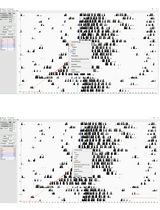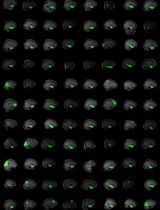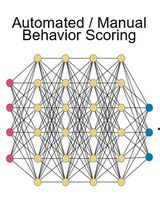- EN - English
- CN - 中文
Using Fiber Photometry in Mice to Estimate Fluorescent Biosensor Levels During Sleep
用小鼠纤维光度法估算睡眠期间荧光生物传感器的水平
发布: 2023年08月05日第13卷第15期 DOI: 10.21769/BioProtoc.4734 浏览次数: 1756
评审: Nafisa M. JadavjiNoa matosevichAlejandro Osorio-ForeroAnonymous reviewer(s)
Abstract
Sleep is not homogenous but contains a highly diverse microstructural composition influenced by neuromodulators. Prior methods used to measure neuromodulator levels in vivo have been limited by low time resolution or technical difficulties in achieving recordings in a freely moving setting, which is essential for natural sleep. In this protocol, we demonstrate the combination of electroencephalographic (EEG)/electromyographic (EMG) recordings with fiber photometric measurements of fluorescent biosensors for neuromodulators in freely moving mice. This allows for real-time assessment of extracellular neuromodulator levels during distinct phases of sleep with a high temporal resolution.
Keywords: Fluorescence (荧光)Background
In comparison to neurotransmitters such as glutamate and GABA, neuromodulators—norepinephrine, dopamine, serotonin, etc.—exhibit a slower and longer-ranging diffuse form of transmission, typically propagated by the activation of metabotropic G protein–coupled receptors (GPCRs). Until recently, electrochemical and microdialysis-based approaches (Shouse et al., 2000; Léna et al., 2005; Park et al., 2011) were the golden standard in the measurement of neuromodulator levels. However, technical and temporal constraints associated with these techniques prohibited the estimation of faster neuromodulator dynamics in freely moving mice. These constraints were recently eliminated by the development of novel fluorescent biosensors, which allow for specific and sensitive measurements of diverse neuromodulators with a high temporal resolution by employing the corresponding GPCRs as the sensing module. This permits inference about causal relationships between neuromodulators and behavioral and biological phenomena.
More specifically, the biosensors are based on the insertion of a perturbed fluorescent protein on the neuromodulator-specific GPCR, which, upon binding of the corresponding neuromodulator, generates an increase in fluorescence (Patriarchi et al., 2018; Sun et al., 2018; Feng et al., 2019). Fiber photometry utilizes this increase in fluorescence to detect neuromodulator levels in freely moving mice. Chronic implantation of an optical fiber in the brain region where the biosensor is expressed allows for the simultaneous delivery of excitation light and collection of fluorescence emission, thus enabling the real-time imaging of neuromodulator levels. This creates the unprecedented opportunity to study fast neuromodulator responses across natural stress-free behaviors such as sleep–wake transitions.
In addition, the combination of biosensor measurements with the use of fluorescent calcium indicators allows for the correlation of the calcium activity of the neuronal population releasing the neuromodulator of interest with the extracellular neuromodulator levels, a method that we and others recently implemented for the study of the locus coeruleus-norepinephrine (LC-NE) system during sleep (Osorio-Forero et al., 2021; Antila et al., 2022; Kjaerby et al., 2022). Furthermore, by combining electroencephalographic (EEG)/electromyographic (EMG) recording measurements with fiber photometric measurements, we were able to assess LC-NE dynamics during sleep and uncover the underlying intrinsic relationship of the LC-NE system, sleep micro-architecture, and memory performance. Finally, apart from their biological significance, these distinct features of norepinephrine signaling during sleep show unique potential as new sleep scoring markers for the refined classification of sleep into wake, micro-arousals, NREM, and REM sleep.
Biosensors not only allow us to assess the relative changes in neuromodulator dynamics during sleep and wake behaviors but also to compare upregulating or downregulating treatment effects. However, to assess the absolute levels of neuromodulators, microdialysis still constitutes the most precise technique, since the delivery and expression of biosensor constructs as well as the placement of the fibers greatly impact the measurement of raw fluorescence levels. For this reason, the raw fluorescence signal is normalized according to a control isosbestic channel, thus allowing for measurements of only relative fluctuations. Importantly, it should also be noted that fluorescent indicators can be subject to tissue artifacts such as pH changes (Bizzarri et al., 2009; Remington, 2011) and hemoglobin levels (Zhang et al., 2022) that affect fluorescence levels. This observation is particularly relevant in the study of sleep and especially during REM sleep (Kjaerby et al., 2022), when marked vasodilation occurs (Turner et al., 2020 and 2023; Bojarskaite et al., 2022) alongside predicted quenching of fluorescence. Therefore, measurement of Ca2+ independent fluorescence by the use of the isosbestic point of the fluorescent indicator or simultaneous imaging of an inert red fluorescent marker (Zhang et al., 2022) is necessary for the removal of these artifacts.
Materials and reagents
Electrode preparation for EEG and EMG
Breakaway female header pins (SWISS MACHINE PIN, Let Elektronik, Sparkfun electronics, catalog number: PRT-00743)
EEG screw electrodes (prefabricated low-impedance EEG screw electrodes from NeuroTek, ~0.8 mm OD, with a length of 2–3 mm)
EMG wire on roll, Teflon-coated stainless-steel wire (W3 Wire International, catalog number: W3 632)
Lead-free soldering tin wire (Goobay, catalog number: 40844)
Super glue (e.g., Loctite Super Glue Power Flex)
Glue accelerator, Insta-Set Super Glue Accelerator (Bob Smith Industrie, catalog number: BSI-152)
6-channel cable with open-ended connection (PlasticsOne, catalog number: 363-000)
Metal braided cable sleeving, tinned copper, 6 mm diameter (CableOrganizer, catalog number: MBN0.25-10FT)
Surgical tape, 2.5 cm (3M, Micropore tape, catalog number: B10428996)
Surgery
Adult mouse (C57BL/6J, 7–9 weeks old)
Preoperative analgesia (e.g., buprenorphine; working concentration: 0.01 mg/mL)
Local anesthetic (e.g., lidocaine; working concentration: 0.2 mg/mL)
Post operative analgesia (e.g., carprofen; working concentration: 1 mg/mL)
Isoflurane (Attane vet®, Piramal, 1,000 mg/g)
Shaver, Aesculap Isis rodent shaver (Agnthos, catalog number: GT421)
70% ethanol (EtOH)
Distilled water
10% iodine solution
1 ml syringes (Chirana T. InjectaM, catalog number: CHINS01)
30 G × 12 mm needles (Sterican®, B Braun, catalog number: 4656300)
Cotton swabs (Th. Geyer, catalog number: 6085021)
Disposable wipes KIMTECH® (VWR, catalog number: 115-2221)
Eye drops (e.g., Ophtha Neutral eye gel)
Surgical marker pen (e.g., Universal Surgical Skin Marking Pen Fine, Premier HH Ltd., catalog number: PEN002)
Biosensor virus (e.g., BrainVTA, WZ Biosciences, Addgene, titer 1012 gc/mL)
Parafilm (Sigma-Aldrich, catalog number: P7793-1EA)
EEG/EMG electrodes (see section A)
Mono optic fiber implant (400 μm core, NA = 0.48, receptacle: MF2.5, Doric Lenses)
Super-Bond C&B Dental cement (Generique International, catalog numbers: 7110, 7111-100, T060E)
Super-Bond C&B Green Activator (Prestige Dental, catalog number: 7115-100)
Recording
White bedding, ALPHA-dri Dust free (LBS Biotechnology, catalog number: 1032003)
White nesting, soft paper wool (LBS Biotechnology, catalog number: 1034007)
Wooden stick, food pellets, water bottle
Plastic cylinder, Plexiglas, H 40 cm × Ø 30 cm
Fiber-optic patch cord (400 μm core, NA = 0.48, 1.5 m, Doric Lenses)
Zirconia sleeves (Ø 2.5 mm)
EEG/EMG patch cords (see section A)
Equipment
The list below describes equipment that we use but that can be replaced with equivalent models.
Electrode preparation for EEG and EMG
Forceps (e.g., Agnthos, Fine Graefe Titanium, catalog number: 11650-10)
Side-cutting pliers (e.g., Stanley, catalog number: 84-079)
End-cutting pliers (e.g., Stanley, catalog number: 84-079)
Soldering clamp stand
Soldering iron (Weller, WE1010 Soldering station, 70 W, 100–450 °C, LCD, ESD, catalog number: H42077)
Multimeter (e.g., XL830L Digital Multimeter)
Scalpel
Microscope (e.g., Olympus, SZ61)
Fine scissors (e.g., Agnthos, catalog number: 14184-09)
Surgery
Flow table
Surgery microscope (e.g., Nikon SMZ745T)
Isoflurane high-flow vaporizer with induction chamber (Kent Scientific, catalog numbers: VetFlo-1205S and VetFlo-0530SM)
Stereotactic frame with nose cone (RWD, catalog number: 68025)
Gooseneck lights (VWR, catalog number: 631-1755)
Heating pads: small surgical pad, big recovery pad (Stoelting, catalog numbers: 53850, 53850M, and 53850C)
Surgery tools: blunt forceps (Fine Science Tools, catalog number: 11002-12), fine scissors (Fine Science Tools, catalog number: 14084-08), fine angled forceps (Fine Science Tools, catalog number: 11251-35)
Screwdriver for EEG screws
Electric drill with drill tip, size 005 (Kopf Instruments, model: 1474)
Stereotaxic drill holder (Kopf Instruments, holder included with the drill model: 1474)
Hamilton 10 μL syringe (World Precision Instruments, catalog number: NANOFIL)
NanoFil 35 G bevel needle tip (World Precision Instruments, catalog number: NF35BV-2)
Microinjection syringe pump (World Precision Instruments, catalog number: UMP3T-1)
Pipette 2 μL (Rainin, catalog number: 17014393) and tips (Gilson, catalog number: F171100)
Holder for the optic fiber implant (RWD, catalog number: 68210)
Timer
Recovery cage
Recording
Insulated recording chambers (ViewPoint Behavior Technology)
16-channel AC amplifier (National Instruments, model: 3500)
Multifunction I/O DAQ device (National Instruments, model: USB-6343)
Fiber photometry system: RZ10-X Lux-I/O Processor (Tucker Davis Technologies) with integrated LED drivers, integrated excitation LEDs (405, 465, and 560 nm, LUX LEDs, Tucker Davis Technologies, Lx405, Lx465, and Lx560 respectively) and integrated LUX photosensors (Tucker Davis Technologies, LxPS1)
Digital handheld optical power meter (Thorlabs, model: PM100D)
Four-port Minicubes [Doric, Ordering code: ilFMC4-G2_IE(400-410)_E(460-490)_F(500-550)_S] per animal
Software
Synapse (Tucker-Davis Technologies)
Sleepscore (ViewPoint Behavior Technology)
MATLAB (Mathworks)
Procedure
文章信息
版权信息
© 2023 The Author(s); This is an open access article under the CC BY-NC license (https://creativecommons.org/licenses/by-nc/4.0/).
如何引用
Andersen, M., Tsopanidou, A., Radovanovic, T., Compere, V. N., Hauglund, N., Nedergaard, M. and Kjaerby, C. (2023). Using Fiber Photometry in Mice to Estimate Fluorescent Biosensor Levels During Sleep. Bio-protocol 13(15): e4734. DOI: 10.21769/BioProtoc.4734.
分类
神经科学 > 基础技术 > 脑电图
神经科学 > 基础技术 > 肌电图
神经科学 > 行为神经科学 > 睡眠与觉醒
您对这篇实验方法有问题吗?
在此处发布您的问题,我们将邀请本文作者来回答。同时,我们会将您的问题发布到Bio-protocol Exchange,以便寻求社区成员的帮助。
提问指南
+ 问题描述
写下详细的问题描述,包括所有有助于他人回答您问题的信息(例如实验过程、条件和相关图像等)。
Share
Bluesky
X
Copy link












